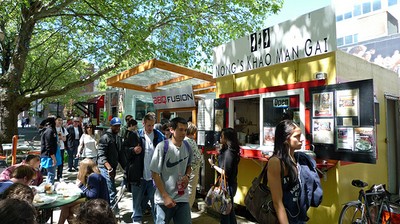 Across North America people are hopping on the food cart bandwagon, something northwesterners know a little something about—CNN Travel recently named Portland the best street food cityin the world.
Across North America people are hopping on the food cart bandwagon, something northwesterners know a little something about—CNN Travel recently named Portland the best street food cityin the world.
While carts have flourished in Portland, Seattle and Vancouver’s street food scenes have sputtered. Why? Both cities have tough laws on the books that prevent a lively street food economy, such as limiting sidewalk food to precooked items like hot dogs or pretzels or requiring food carts to park only on private property.
Although these cities have been slow to get food carts cooking, both are taking steps to make food cart operations more viable. Vancouver is eventually trying to sanction more than a dozen new carts to set up shop around the city. For its part, Seattle is considering loosening some long-standing street food laws.
Like most things, food carts roll into town with both pros and cons. I won’t deny that there are some legitimate worries that go along with these meals-on-wheels—health safety being a prime one. But for me, the benefits of having a thriving, affordable street food scene outweigh the downsides.
I won’t lay them all out here, but I wanted to get across some of the major issues that arise. Let’s start with the cons:
- Sanitation and quality standards: We’ve all seen ’em—so-called “roach coaches” whose appearance is less than savory. Who knows what you might catch from mystery “street meat” prepared in the back of a 1960s school bus. Indeed, operating a make-shift restaurant squeezed into a tattered van or truck creates some unique difficulties for keeping a workspace hygienic.
- Noise: Portland is known for its food cart “pods” that exist not only in the urban core, but also in the more-residential surrounding areas. It makes sense—while downtown carts often cater to the day-time lunch crowd, there’s also an enormous appetite for cheap, greasy food from the after-hours, bar-hopping crowd. But while last-call diners may enjoy socializing loudly over tacos and fried pies, nearby neighbors might think otherwise.
- Litter: Similar to excess noise, food carts have the potential to create a new breed of waste and litter. Carts often lack adequate receptacles to collect discarded wrappers, cups, and utensils—all of which could end up in the street.
- Restaurant business: Restaurant owners often complain about food carts creating unfair competition. After all, a cart parked on somebody else’s land doesn’t have to pay property taxes, can easily move if business falters, and offers copious food for significantly less than a brick-and-mortar sit-down with far higher overhead.
And then there are the pros:
- Walkability: Put simply, food carts don’t come with drive-thrus. In 2008, the City of Portland commissioned a report looking at various aspects of the food cart biz and found that 65 percent of customers walked to food carts. Having a multitude of affordable food options nearby adds to a community’s walkability. And while your stroll to a food cart might not wipe out the calorie intake from a greasy plate of poutine, it’s still better health-wise than driving to KFC to pick up a Double Down.
- Foot traffic: Portland’s study also revealed the local business owners often like having food trucks in their neighborhood because they increase foot traffic. Forty percent of the businesses interviewed in the study thought the carts had increased foot traffic on the streets—meaning more potential customers for local shopkeepers.
- Smart use of urban space: Roger has been writing a bit about how to make vibrant and functional urban spaces. Many argue that food carts make a great addition to public spaces—filling corner parks with alluring aromas and adding a sense of urban vivacity to a city’s shared spaces. Additionally, carts usually help transform boring (gravel lots), inefficient (street-level parking lots), or underutilized spaces (like large plazas) into lively, productive areas of commerce.
- Career ladders: When Portland looked at its food cart vendors, they found more than half were born outside the US, and two-thirds agreed that operating a food cart was a good way to support their family. However, many of these owners get into food carts hoping to transition to a storefront business—a costly leap that few can make. Still, food carts often provide a living wage to folks who may have had a tough time getting by otherwise.
- Affordability: In cities with lots of vendors, street food is cheap! Once food carts go from novelty (Seattle) to industry (Portland), food carts can offer competitive prices for their fare, making possible a night out (literally!) to those who might not be able to afford a restaurant.
That’s certainly not all of the up- and down-sides of a flourishing food cart industry—but it’s some of the major ones. And as for those cons? Often, they can be resolved by smart planning like providing ample trash cans; assigning space near, but not next to, residential areas; and requiring thorough health code inspections (in Portland, food carts are subject to the same biannual inspections as their brick-and-mortar counterparts).
Plus, there are ways to make the pros even better. Many vendors qualify for small business loans that could help them make the jump to a storefront restaurant, but most vendors don’t know it. Increasing awareness could turn food carts into true career ladders. As urban areas develop, working in space for carts, along with seating, shelter, and restrooms, can help a food cart culture thrive.
Now I want to hear from you: what are other pros and cons of food carts? If you’re from Portland, what do you think you’re doing right? Or if your city lacks carts, what would you like to see your city do to help them grow?
Photo courtesy of Flickr user Camknows, under a Creative Commons license.









Matt the Engineer
Seattle has a long way to go. Even the linked Stranger article is a bit depressing. So Seattle’s about to expand it’s list of allowed food past popcorn and hot dogs. I suppose that’s better than nothing. But only when it can include street food like Jian Bing will I really be happy.As for the issues with street food, they’re all easily solved. 1. Sanitation: inspectors, paid from license fees. And not inspecting secondary issues like having 3 sinks – testing actual food. 2. Noise: Start with sanctioned areas. 3. Litter: Garbage cans (duh). 4. Competition: Not an issue. Think it’s more profitable to have a cart than a restarant? Buy a cart.
James
Update From Vancouver:Hi Eric, Interesting article. Things have changed quite alot in Vancouver since July 30th (the date of the piece linked to this article on Van’s street food scene)The program actually started on July 31st, 2010. After an extremely slow start, vendors have been popping up around downtown, offering a variety of excellent food choices.There are things that need to be ironed out but the enthusiasm and hard work of the vendor community is making an impact. Pre-cooked food is not the only food allowed on sidewalks as you have suggested. You can find freshly made Japanese crepes, chicken satay skewers and freshly baked croissants to name a few.We have a long way to go before we have something as big as Portland, but to suggest that it has been a failure not even 2 months in is a bit premature.Get hungry, get out there and eat on the streets!Complete vendor maps and information our food carts here:http://vancouverstreeteats.ca/
Eric Hess
Thanks for the update, James. I read that things had a slow start, but am glad to hear they’re picking up!
Tony Columbo
Food carts are a sign of a bad economy. People cannot afford restaurants.The rat infestation in downtown Portland is absolutely terrible and getting worse. The cities vector control can’t keep up. One cannot walk during the day without seeing at least one dead rat in the street and another gnawing on its leg. And at night they are everywhere. From Waterfront Park to PGE Park I have never witnessed so many rats. And with all the empty store fronts in downtown Portland, it’s become a ghost town, there are plenty of places to live and they are thriving on food left out by the food cart venders which are becoming strung out all over town.Downtown is a filthy dirty city. And food carts are a very big part of the problem. “In downtown Portland, you’re never more than 50 feet from a rat.” http://www.oregonlive.com/portland/index.ssf/2010/04/springtime_in_portland
Tom Carter
Part of the success of food carts in Portland is accidental: the city’s zoning regulations don’t prevent them. Food carts need to be on wheels and on a trailer 16 feet long or less. These trailers are categorized for parking purposes as “medium truck” size. Food carts have to be parked in a zone that allows the parking of medium trucks – basically in commercial zones, not residential. And since they’re parked, they are supposed to be in a parking lot.In a couple sites, property owners have done the work to convert a vacant lot into a parking lot, which then can be used for parking these carts. A good example is at the corner of NE Mississippi and NE Skidmore in the Mississippi District.But I don’t think the city government sees any advantage in cracking down on food cart vendors. The city already gets a lot of criticism for being anti-small-business, so it’s focused on any health and safety problems, rather than zoning issues. By taking a relaxed attitude about minor infractions, it’s allowed local creativity to take off.